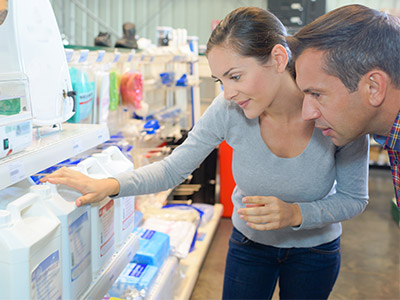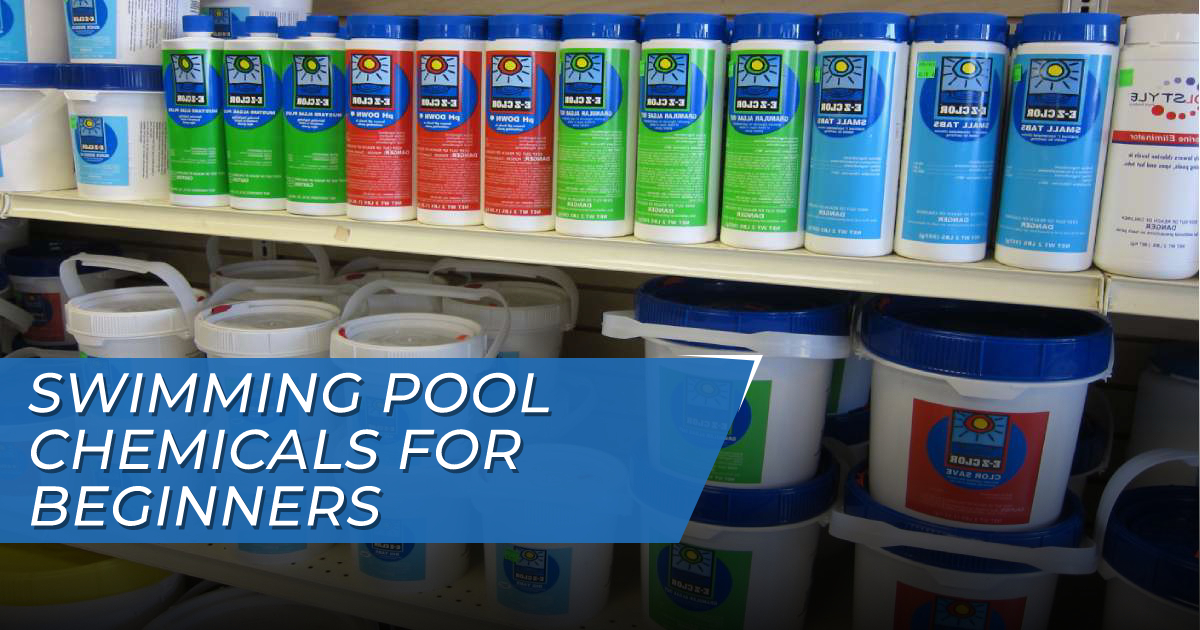Swimming Pool Chemicals for Beginners
While a filter does a lot of the work in keeping your pool clean, there is also a fine balance of swimming pool chemicals that help your pool look clean and pure. A crystal-clear swimming pool is a beautiful thing – somewhere to cool down and gather around, and an endless source of joy for adults and children alike. Keeping a pool looking sparkly fresh, however, requires some maintenance.
While finding the perfect water chemical balance for your pool can be a complicated process, you don’t need to be a chemist to understand the basics of pool chemicals. In this article, we will cover the fundamentals of pool care and answer some common questions regarding chemicals for swimming pools.
Related Article: How to Maintain a Swimming Pool: Getting the Chemistry Right
Common Swimming Pool Chemical Problems
If your pool isn’t looking its best, there are a few common issues that can be easily solved with the right approach. Whether the problem is murky waters or skin irritation after swimming, a clean and healthy pool is definitely within your reach with the proper treatment and pool chemicals. Some typical problems can include:
Algae
While algae are naturally occurring aquatic organisms and in small amounts are not dangerous to humans, if left untreated and allowed to flourish, the algae can foster the growth of bacteria that can be harmful to swimmers. There is a whole color wheel of algae that can appear in swimming pools – green, yellow, pink, and even black algae can make your swimming pool look murky and unappealing. The good news is, they can all be treated by algaecide and other pool chemicals to keep your pool algae-free.
Related Article: How To Get Rid Of The Algae In Your Pool: Part 1 The Basics
Chemical Imbalance
Too many swimming pool chemicals can cause irritation of the skin and/or eyes, while not enough can cause bacteria and fungus growth that can, in turn, lead to illness and disease. Overchlorination and water that is too alkaline or too acidic can all have adverse effects like skin rashes and respiratory irritation. Other less dangerous side effects can mean ruined swimsuits since chlorine is a bleach, and this is why it’s so important to find that perfect chemical balance for your pool with the right combination and level of pool chemicals.
Pathogens
Pathogens are bacteria, viruses, and other microorganisms that can cause disease and be dangerous to humans. Often these make it into swimming pools through the blood, saliva, and skin of infected swimmers. Pathogens like E. Coli, Salmonella, and even hepatitis A can all lurk within the depths of your pool, but luckily, disinfectants can kill most germs and keep swimmers healthy.
Scale Deposits
Scale deposits are white, gray, or brown deposits on the walls and fixtures of your pool and are usually caused by a high calcium concentration, high pH or high alkalinity. Not only do scale deposits look unattractive, but they can also be sharp and abrasive to the skin and cause filtration problems if allowed to grow. Scale deposits can be dealt with by adjusting the pH, alkalinity, and calcium hardness levels of your pool.
High/Low pH Levels
Your pool’s pH levels are the relative proportion of acids and alkalis in it, and the pH scale ranges from 0 (extreme acidity) to 14 (extreme alkalinity). Your pool’s pH levels should hover between 7.2 and 7.8. Maintaining a pool’s chemical balance is an ongoing process, and if your pool is suffering from a pH imbalance, there are some unwelcome side effects. Water that’s too acidic will corrode metal equipment and irritate skin while water that is too alkaline can cause scale deposits and cloud the water.
Related Article: Proper Water Balance and Testing
Swimming Pool Chemicals – What Do They Do?
There are several essential chemicals for pools, each with a specific function and purpose, and an ideal pool has a balanced combination of these chemicals. Some chemicals must always be present, while some are only used when specific problems arise. Below are some of the most widely used chemicals for swimming pools.
Chlorine
 This is the most common chemical for pools, and it’s a crucial part of the equation of a clean pool. We won’t get too technical, but chlorine reacts to pool water and breaks down into many different chemicals, including hydrochloric acid and hypochlorous acid. The latter enters the wall of bacteria and other harmful microorganisms, killing them and keeping swimmers safe and healthy.
This is the most common chemical for pools, and it’s a crucial part of the equation of a clean pool. We won’t get too technical, but chlorine reacts to pool water and breaks down into many different chemicals, including hydrochloric acid and hypochlorous acid. The latter enters the wall of bacteria and other harmful microorganisms, killing them and keeping swimmers safe and healthy.
A powdered form of chlorine is also used for “pool shock”, or super-chlorination. This means raising the chlorine level of the swimming pool up to ten times the regular level for a short time to remove “combined chlorine,” which is a combination of inactive chlorine and harmful bacteria.
Bromine
Bromine can be used as an alternative to chlorine, with largely the same sanitizing effects. It kills microorganisms, just like chlorine does, but the main difference is that chlorine’s effects become feebler over time and the above-mentioned pool shock is how pool owners deal with that issue. Unlike chlorine, bromine does not lose efficacy over time, but it does become less stable when exposed to UV light from the sun; thus, it is best used for indoor pools.
Algaecide
As the name suggests, algaecide is a pool chemical that helps prevent algae from growing. Even the best-maintained pools can sometimes suffer from an algae problem, as spores can come into your pool via wind or swimmers. While chlorine is often enough to kill algae, yellow and black algae are chlorine-resistant, and if they are present in your pool, you may need to consider using an algaecide. There are two types of common algaecides – copper-based or ammonia-based.
Clarifiers
Suffering from a murky pool? Not only do cloudy pools look unsightly, but they can also be a real danger to life – decreased visibility means you may not see swimmers underwater. Clarifiers are a category of swimming pool chemicals that can help with this problem. While a filter is your best bet to keeping your pool sparkling clean, clarifiers help your filter capture all the tiny particles that make the water cloudy through coagulation. This means that clarifiers help form small particles into bigger particles, making it easier for your filter to catch them.
pH Balancers
To balance the pH levels of your pool, you need to know whether it’s too acidic or too alkaline. If your water’s pH is too low ( (7.2 or less), Sodium Bicarbonate is a chemical that can be used to return the water to an ideal pH balance. If your water’s pH is too high (7.8 or more), pool acid is the way to go. Remember to adjust pH levels incrementally, with continuous testing throughout.
Test Kits
Obviously not a chemical as such, test kits are, however, an essential tool that helps you determine the chemical balance of their pools. For a detailed analysis from a professional, water samples from your pool may be brought in to a pool service company, but at-home test kits can also yield valuable information. There are many types of test kits available, with the very basic ones testing for pH, chlorine, total alkalinity, and calcium hardness.
Related Article: Why is My Pool Cloudy? A Full Guide On Causes and What To Do
Can Chemicals for Swimming Pools Cause Damage?
The material your pool is made from can certainly be damaged by the improper use of chemicals. If your pool has a vinyl liner and you add pool shock directly to the water, the granules can settle on the bottom of the pool and damage the liner. The liner can then become brittle and cause leaks, resulting in expensive repairs. While vinyl linings do wear out over time, their lifespan can be maximized by having a proper chemical water balance.
Pool plaster can also suffer significantly from a chemical imbalance, with calcium deposits causing the most damage and leaving rough areas that may need to be sandblasted to repair. Another culprit is algae, which can damage plaster, leaving it looking dull and unattractive.
Related Article: How To Shock a Pool: A Step By Step Guide
Can Pool Chemicals Be Dangerous for People?
Chemicals for swimming pools are a necessary and helpful way of keeping a pool clean and free of harmful microorganisms. Using safety measures like protective eyewear, chemical masks, and chemical-resistant gloves when handling pool chemicals is vital for self-protection. Chemicals can be dangerous when improperly used, and adding the correct amounts of chemicals can make a difference between a safe pool and a dangerous one.
Not enough chlorine, for example, can leave your pool teeming with harmful bacteria while too much chlorine can leave swimmers with irritated eyes, skin, and respiratory systems. Measuring exact amounts and following instructions when adding chemicals to your pool is the principal method of avoiding too much or not enough of a particular chemical. Storing pool chemicals in a cool, dry, and well-ventilated place, out of reach of children is another easy yet crucial step in maintaining pool safety.
Related Article: Cheap Pool Chemicals: Does it Matter Which Brands You Use?
Pool Chemicals – the Final Say
Think of your pool as a chemical ecosystem that must be continuously maintained at the correct levels. Things like rain, algae spores brought in by the wind, and even sunscreen from swimmers’ skin can all alter the delicate balance of the chemicals in your pool. Regular testing and care is the best way to ensure your pool is a safe environment for all swimmers, and the recommended amounts are 2-3 times a week during summer and once a week for less busy seasons. The materials your pool is built out of, climate, and how often your pool is used are all factors that can determine which pool chemicals you should use and how often. A professional can take the guesswork out of how much, how often and which types of chemicals you should use in your pool. Get in touch with one of our certified technicians at our locations in New Tampa, Lutz, and Land O’ Lakes today to find out how to properly handle pool cleaning & maintenance and get a personalized analysis of your pool.

